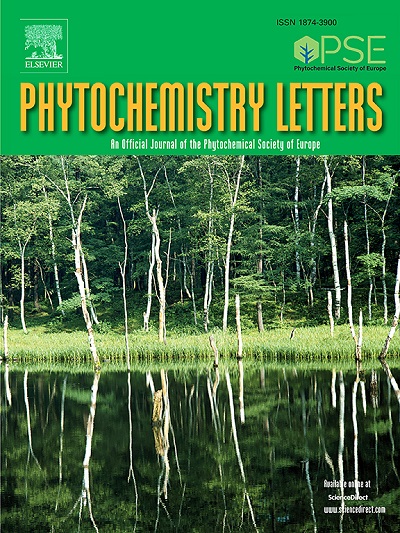雪松中的 8',9'-双新木质素及其抗血管生成活性
IF 1.3
4区 生物学
Q4 CHEMISTRY, MEDICINAL
引用次数: 0
摘要
从 Cedrela odorata(甜菜科)的茎皮中分离出了两种以前未曾描述过的 8',9'-双新木质素,即 9-乙酰托宁 C(1)和 threo-guaiacylglycerol-β-methyl vanillate ether(2)、此外,还分离出了 4,5-二氢布卢门醇 A、2-(3,4-二甲氧基苯基)乙基-β-d-吡喃葡萄糖苷、莨菪亭、高香草醇和 7-麦角甾烯-3,6,9-三醇。所有化合物都通过一维和二维核磁共振以及 HRESIMS 数据进行了表征。这些新化合物以及从我们的化学库中获得的其他木脂素,即赤式-4,7,9,9'-四羟基-3,3'-二甲氧基-8-O-4'-氧新木脂素(3)、脲木脂素苷(4)、 secoisolariciresinol 9-O-β-D-glucopyranoside (5)、然后通过体内斑马鱼胚胎试验评估了这些化合物的抗血管生成活性。化合物 1、2 和 3 的抗血管生成效果最好,而化合物 4 和 5 在处理斑马鱼胚胎后对 EAP 的释放有轻微的抑制作用。其中,化合物 2 在 10 μM 的浓度下对 EAP 释放的抑制率为 42.56%,与用作参考化合物的 2-甲氧基雌二醇相似。本文章由计算机程序翻译,如有差异,请以英文原文为准。
8’,9’-Bis-nor-neolignans from Cedrela odorata and their antiangiogenic activity
Two previously undescribed 8’,9’-bis-nor-neolignans, 9-acetyltoonin C (1) and threo-guaiacylglycerol-β-methyl vanillate ether (2), were isolated from the stem bark of Cedrela odorata (Meliaceae), together with 4,5-dihydroblumenol A, 2-(3,4-dimethoxyphenyl)ethyl-β-d-glucopyranoside, scopoletin, homovanillic alcohol, and 7-megastigmene-3,6,9-triol. All compounds were characterized by 1D and 2D NMR and HRESIMS data. The new compounds and other lignans obtained from our chemical library, namely erythro-4,7,9,9’-tetrahydroxy-3,3’-dimethoxy-8-O-4’-oxyneolignan (3), urolignoside (4), secoisolariciresinol 9-O-β-D-glucopyranoside (5), icariside E3, and erythro-4,7,9,9’-tetrahydroxy-3,3’-dimethoxy-8-O-4’-oxyneolignan-9’-O-β-D-glucopyranoside, were then evaluated for their antiangiogenic activity by the in vivo zebrafish embryos test. Compounds 1, 2, and 3 exhibited the best antiangiogenic response, while 4 and 5 showed mild inhibitory effects on EAP release after treatment of zebrafish embryos. In particular, compound 2 induced an inhibition of 42.56 % at 10 μM, similarly to 2-methoxyestradiol used as reference compound.
求助全文
通过发布文献求助,成功后即可免费获取论文全文。
去求助
来源期刊

Phytochemistry Letters
生物-生化与分子生物学
CiteScore
3.00
自引率
11.80%
发文量
190
审稿时长
34 days
期刊介绍:
Phytochemistry Letters invites rapid communications on all aspects of natural product research including:
• Structural elucidation of natural products
• Analytical evaluation of herbal medicines
• Clinical efficacy, safety and pharmacovigilance of herbal medicines
• Natural product biosynthesis
• Natural product synthesis and chemical modification
• Natural product metabolism
• Chemical ecology
• Biotechnology
• Bioassay-guided isolation
• Pharmacognosy
• Pharmacology of natural products
• Metabolomics
• Ethnobotany and traditional usage
• Genetics of natural products
Manuscripts that detail the isolation of just one new compound are not substantial enough to be sent out of review and are out of scope. Furthermore, where pharmacology has been performed on one new compound to increase the amount of novel data, the pharmacology must be substantial and/or related to the medicinal use of the producing organism.
 求助内容:
求助内容: 应助结果提醒方式:
应助结果提醒方式:


